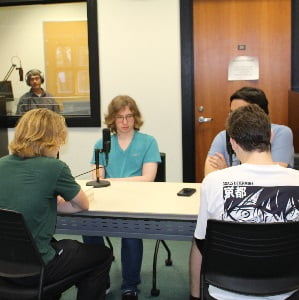Leader News Music Professor Uses Podcasting As Assessment Tool
A Hawks in Flight Feature
Students in Associate Professor Meghan K. Sheehy‘s “Rock Music History” class (MUSI 176) were asked this semester to break new  ground at Hartwick: record podcasts in the new Production Studio on the third floor of Clark Hall.
ground at Hartwick: record podcasts in the new Production Studio on the third floor of Clark Hall.
“I’m always looking for alternative forms of assessment that are more relevant to our students’ lived experiences,” Sheehy said. “There isn’t a lot of practical application of the traditional testing format, so I am exploring the use of podcast creation to have students apply content knowledge immediately, in socially relevant ways.”
Sheehy divided her class – made up mostly of non-music majors – into five groups. During the semester, each group will create four podcasts. They will use the podcasts as a way to analyze and interpret a self-selected piece of music through the framework of class discussions. The rest of the class will have a few days to offer feedback on the podcast, and the following group can use that feedback to improve their own efforts. “Even though students aren’t recording every week, we will still hopefully grow as a class in content uptake, application, and delivery,” she said.
“With the first group, I expect to hear discussion centered on the seven elements of music,” Sheehy explained. “Melody, harmony, rhythm, texture, timbre, form, and volume. As the class grows in content knowledge, the students will likely reference these elements with growing layers of complexity.”
The first student group, featuring Sam Bagley ’26, Jake Buchman ’24, Evan O’Flynn ’25, and Rob Noury ’25, selected perhaps an unconventional piece to dissect: Holy Diver, a 1983 cut by the heavy metal band, Dio. After playing the selection, the group spent the rest of its 10-minute segment debating the instrumental and vocal strengths of the song.
“I think one of the first things to talk about, particularly pertaining to what we’ve been talking about recently [in class], is the way they utilize texture in the beginning,” Buchman said. “And it came in off the very soft dynamic with the synths, into that very iconic guitar riff.”
The group agreed.
“[This song is] one of the best examples of using soft dynamics in recorded music,” Buchman noted.
From the guitar solo, “where there are those the moments of space,” to the drum fills that “hearkened back to the song’s atmospheric beginning,” to the “driving” guitars that “have a sense of urgency,” the students offered critical insights on the song that belied the fact most of the group were non-music majors.
Once captured, the conversation will be the foundation of what Sheehy sees as another tool to help augment the concepts she teaches.
“We will use the podcast assessment data to help students hone their process each week in class,” she said.
Although this is new for her and her students, Sheehy is going to stick with the podcast-format assignment because it helps eliminate the visual aspect of YouTube, an assessment tool she piloted last spring. “I didn’t want to add the stress of ‘What do I look like?’ onto ‘What do I sound like?’” she said.